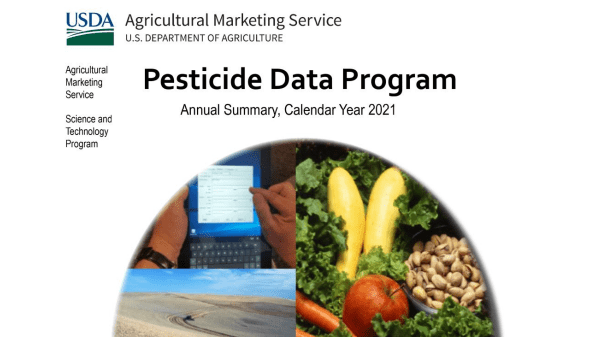USDA’s Pesticide Data Program has just released its report for calendar year 2021.
The PDP surveys pesticide residues in food crops—notably fruits and vegetables—as collected at points of final distribution (as opposed to the farm gate).
It reports that in 2021:
“Over 99 percent of the samples tested had residues below the tolerances established by the EPA [Environmental Protection Agency] with 24.0 percent having no detectable residue…”
“Residues exceeding the tolerance were detected in 0.53 percent (54 samples) of the total samples tested (10,127 samples). Of these 54 samples, 29 were domestic (53.7 percent), 24 percent were imported (44.4 percent), and 1 was of unknown origin (1.9 percent).”
The commodities tested in 2021 were blueberries (fresh and frozen), broccoli, cantaloupe, carrots, cauliflower, celery, eggplant, grape juice, green beans, peaches (fresh and frozen), pears, plums, summer squash, sweet bell peppers, tangerines, watermelon, and winter squash, as well as butter and corn grain.
Each year the PDP samples only a small number of the types of produce on the market.
“Typically,” the report explains, “the selected commodities represent the highest U.S. consumption rates, with an emphasis on foods consumed by infants and children. Due to budget limitations, the high consumption commodities are cycled through the program approximately every 5 years rather than tested continuously.”
By this criterion, commodities that are likely to be up for testing soon include apples (whose last test date was September 2016), cherries (last tested in March 2016), lettuce (last tested in June 2017, although organic lettuce has not been tested since December 2009), and onions (last tested in December 2017).


Some commodities have not been tested for a long time, such as pineapples (last tested in June 2002), papaya (last tested in June 2012), and raspberries (last tested in December 2013).
Not all states are represented in the testing, although the rotating total is meant to include approximately half of the American population each year. States where testing occurred in 2021 were California, Colorado, Florida, Maryland, Michigan, New York, Ohio, Texas, and Washington.



